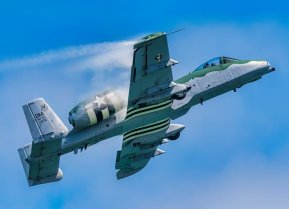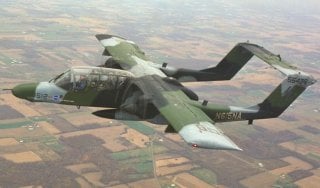OV-10 Was the U.S. Military Warplane Born in a Garage
The North American Rockwell OV-10 Bronco remains one of the lesser-known aircraft in the U.S. military inventory. Not as flashy as the SR-71 or the F-22, not as ubiquitous as the F-16 or F/A-10, not as pioneering as the F-117 or B-2, and not as controversial as the A-10 or B-1, the OV-10 performed its role quietly for three decades.
The North American Rockwell OV-10 Bronco remains one of the lesser-known aircraft in the U.S. military inventory. Not as flashy as the SR-71 or the F-22, not as ubiquitous as the F-16 or F/A-10, not as pioneering as the F-117 or B-2, and not as controversial as the A-10 or B-1, the OV-10 performed its role quietly for three decades.
And the OV-10 has what must be the most unique procurement story in U.S. military aviation history.
OV-10 Bronco: No Request for Proposal Required
In the early 1960s, U.S. Marines W.H. Beckett and Colonel K.P. Rice were neighbors in Santa Ana, California. The two men would sit on Beckett’s patio and rant about Navy and Air Force aviation trends, a developing obsession with swept-wing fighters and exotic weapons.
Beckett called it “the era of boom and zoom.” The two Marines lamented the decline of conventional weapons and the related neglect of close air support platforms.
“What was needed, Beckett and Rice determined, was a scrappy observation airplane that could not only find enemy combatants but also attack them on the spot. They envisioned a twin-engine turboprop that would be faster than helicopters, yet slower and more versatile than jets,” William E. Burrows wrote for Smithsonian magazine. “Furthermore – and this was revolutionary – the aircraft had to be capable of taking off and landing in so short a space that it could be stationed with battalions in combat areas, not at some far-off air base.”
The crazy part is that Beckett and Rice decided to just build the airplane. “The two men built as much of a full-scale fiberglass model as would fit in Rice’s garage (because of the space limitation, attaching the wings was out of the question), and then began trying to sell the concept to “The System,” Burrows wrote.
Convincing the Military
Despite meeting reluctance initially, the homegrown bid gained momentum when a “tri-service” (Navy, Air Force, Army) contract requirement was issued for the Light Armed Reconnaissance Aircraft (LARA). LARA was issued to procure a versatile, light attack and observation aircraft, something that could handle the jungle fighting the U.S. would be participating in for the next decade-plus.
Specifically, LARA called for a twin-engine, two-man aircraft able to carry about one ton of cargo and six paratroopers, and capable of handling +8 and -3 g’s. Additionally, LARA required the new plane to be able to take off and land from an aircraft carrier and also take off from a conventional runway (or road) in just 800 feet. The plane would be able to fly at 350 miles per hour and would carry a variety of cannons, rockets, and air-to-air missiles.
After considering nearly a dozen proposals, the LARA program selected North American’s OV-10 Bronco, which was essentially Beckett and Rice’s garage project. The finished project “was a much larger aircraft (double the wingspan) with more systems than the two friends had originally planned. “‘But it was still recognizable,’ says Rice,’” Burrows wrote.
The plane was visually distinct; the OV-10 had a central nacelle holding the two pilots and cargo – and twin booms holding the twin turboprop engines. Connecting the two booms was a shared horizontal stabilizer, a unique feature.
The OV-10 served in the Air Force, Marine Corps, and Navy – plus was exported to several other countries including Thailand, the Philippines, West Germany, and Morocco – and saw extensive action during the Vietnam War.
Not bad for a garage project.
About the Author
Harrison Kass is a prolific defense writer with over 1,000 published articles. An attorney, pilot, guitarist, and minor pro hockey player, he joined the US Air Force as a Pilot Trainee but was medically discharged. Harrison has degrees from Lake Forest College, the University of Oregon, and New York University. He lives in Oregon and listens to Dokken. Follow him on Twitter @harrison_kass.


